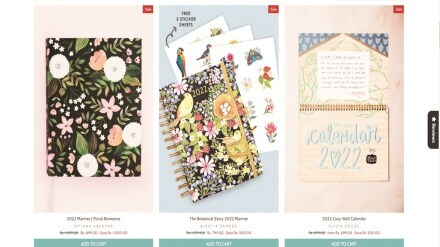The Covid-19 pandemic seems to have benefitted a niche category of stationery products — planners and journals. Multiple brands and illustrators who had been registering slow growth for premium stationery products are now seeing a steady flow of orders for productivity planners, gratitude/ wellness journals, pregnancy journals, etc.
According to industry estimates, India’s stationery market was worth $6.5 billion in 2020, of which, the paper category accounted for $4 billion. Overall, the industry has witnessed a compounded annual growth rate of 20% since 2015. Products such as planners, journals, etc., are popular in the gifting category as well, especially online. Analysts say this segment is seeing a boom in sales with new entrants and the market is almost doubling in size. But is this growth sustainable for these direct-to-consumer (D2C) premium stationery brands?
Planned foray
Saurabh Sharma, founder and CEO, Futurewagon, says that the market for journals and planners has expanded since 2016. Till then, the awareness was limited mainly to affluent international travellers with exposure to such products, and who would place orders with illustrators like Alicia Souza for calendars and planners. While awareness has grown, “80% of the market is still concentrated in cities such as Bengaluru, Mumbai and Delhi,” says Sharma. Instagram has democratised reach and now consumers from tier-II and tier-III cities are also ordering from D2C stationery brands.
Darshani Dani, founder, TheTrove, says the focus on self-care and mental health has given a fillip to the sale of gratitude journals, daily planners, etc. “Due to pandemic-related anxiety and uncertainty, people felt anchored in routines such as writing in journals,” she says. Dani says D2C sales account for 40% of revenues while wholesale buying constitutes the rest. Brands such as TheTrove typically showcased products at offline exhibitions or flea markets, before the pandemic. “Lack of offline events has eroded a chunk of the consumer business,” she says.
Odd Giraffe, a firm that focusses on planners and journals, received 35,000 orders in 2021. While it also sells scented candles and iPhone cases, company co-founder Karan Joshi now wants to focus his efforts on the stationery vertical. A planner costs about `1,499 while an open-ended journal costs `599. “In a category that is largely commoditised, we would like to build a brand for premium stationery through value-additions such as customisation,” he says.
Writing on the wall
Most D2C brands are led by an illustrator and their design aesthetic. This single illustrator dependency could be a hurdle in the path to scaling up business, say analysts. Futurewagon’s Sharma says this is why he took the “house of brands” approach. “We needed to de-risk the business and expand our range of products. We now have about seven brands in our portfolio,” he says.
Anand Ramanathan, partner, Deloitte India, points out brands in the premium stationery space can increase their relevance if they are present in a variety of categories. “Product diversification is important for scaling a brand,” he says. Furthermore, remaining purely a D2C brand could limit reach, so it helps to tap e-tail marketplaces.
Social media platforms like Instagram and word-of-mouth have worked to an extent; the former is useful from an awareness creation perspective, but not necessarily sales. Scaling up through offline sales remains a challenge. Futurewagon’s store in a Bengaluru mall was capital-intensive and did not take off, for example. Dani does not have an offline presence yet while Joshi’s planners are on sale at Crossword stores in four cities and a few boutique stores.
